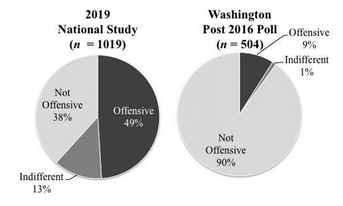
Why the huge difference? The Washington Post poll suffered from methodological flaws. It had a relatively small sample size and relied upon respondents to self-identify as Native Americans instead of confirming that the respondents were officially enrolled in tribes. In contrast, the team of psychologists led by Fryberg strove for accuracy by conducting to-date the “largest scientific study of the relationship between Native American identity and attitudes toward Native mascots.” They recruited “a sample of 1,000 Native American participants, which is twice the size of previous polls and would achieve sufficient variation in Native American demographics and identities to test our hypotheses.”
The study is more nuanced than the earlier poll by the Washington Post. It sought to get away from characterizing Native Americans opinions as “a single percentage.” The authors continued that “In reality, many factors (e.g., life experiences, demographics, and social identities) are likely to differentiate Native individuals’ attitudes toward mascots.”
In fact, the authors find that opposition to mascots and fake dances and chants increase the more respondents identify with their culture and participate in religious and cultural activities. For example, 70 percent of respondents that frequently engage in Native American culture find mascot headdresses offensive compared to 38 percent of respondents that do not frequently engage in Native American culture. The study found similar results on questions about the Tomahawk chop and when fans imitate Native dances.
Why does this matter? For starters, most people would be offended if a sports team used a mascot to inaccurately portray their religion or culture. Secondly, as the authors state, “Far from trivial, mascots are one of the many ways in which society dehumanizes Native people and silences Native voices. These representations not only shape how non-Natives see Native people, but also how Native people understand themselves and what is possible for their communities.”
Unfortunately, this study does not have the same megaphone that the Washington Post study has. As the authors point out, the Washington Post has a readership of 86 million people whereas Native American journals typically have readerships of around half a million. Rebrand Washington Football (RWF) will do our part to publicize the implications of this study and we hope others will also.
Authored by Stephanie A. Fryberg, Arianne E. Eason, Laura M. Brady, Nadia Jessopa, Julisa J. Lopeza, the study is called, “Unpacking the Mascot Debate: Native American Identification Predicts Opposition to Native Mascots.” It will be published later this month in the journal Social Psychological and Personality Science.
We hope that team owner Mr. Snyder and his staff at Washington football team headquarters read it.
 RSS Feed
RSS Feed